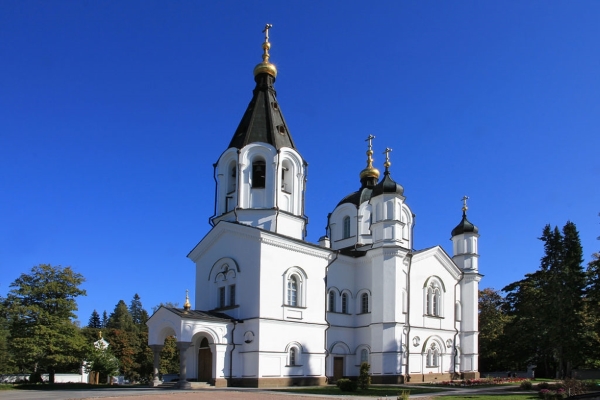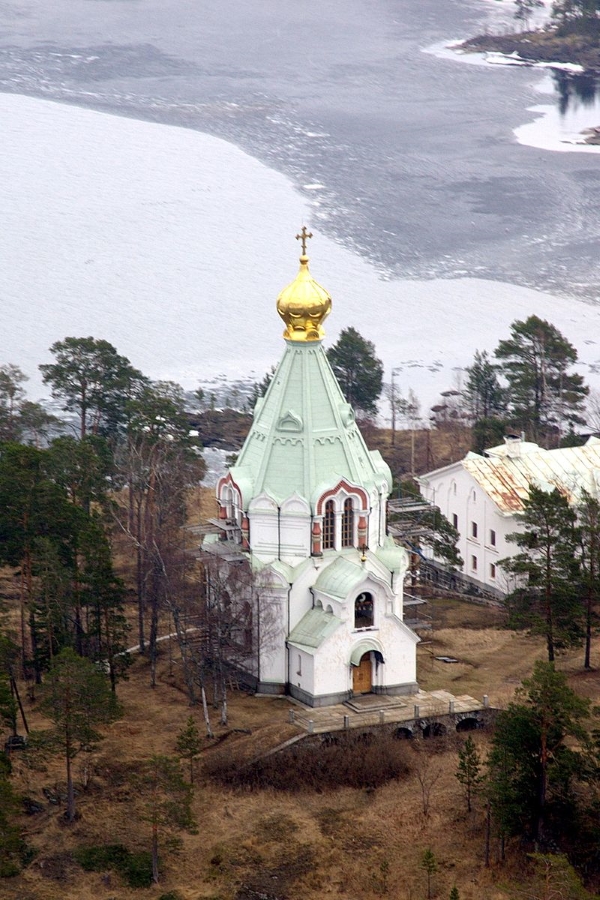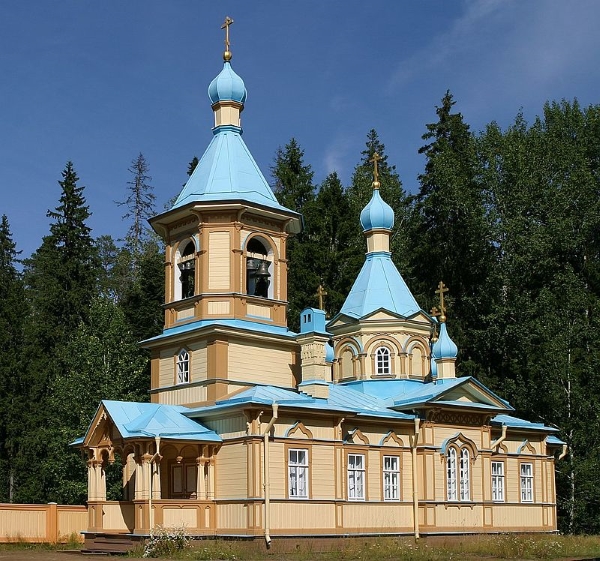On my random trips to thrift shops and antique malls, I from time to time stumble on some really unexpected treasures, like a genuine antique XIX century Russian brass samovar (I wrote about it on my FB page a short while ago) or this beautiful Russian Orthodox icon. I don't pretend to be an expert on any of these things - samovars, icons or antiques for that matter. But I am an enthusiastic learner and even more enthusiastic appreciator of such things. So if they are within my budget, I happily offer them my home and try to find out their story.
Valaam Monastery (1792)
My icon is most definitely not antique, but it is a beautifully made print of the Valaam Mother of God (God-bearer would be the right term as well). My modest photo does not reflect all the vibrancy of colors or the brilliant intricate gold design. The image is on a wood plank which is about the size of my photo - just a tad bigger. Even though I can't know how this Russian icon got into an American antique mall, I was eager to learn about this stunning image.
From the very beginning, it struck me as an unusual icon. I am used to seeing portraits, not the whole figure of Mother of God on Russian Orthodox icons. So I started doing a research to learn more about it. Apparently, the Valaam Mother of God was painted in 1878 and then was either misplaced or kept in storage for almost 20 years, when Natalya Andreeva from Saint Petersburg, who visited the Valaam monastery as a pilgrim in order to heal, found it. She made two or three trips to the monastery. One version of the story says that during the very first trip, she saw this icon and when she came back home, felt much better, though not completely well yet. She then decided to make another trip to Valaam - a far away monastery on the Valaam Island in the midst of the Ladoga Lake, over 200 km North-East of St Petersburg. When Natalya came to the place where she saw the icon for the first time, it was not there. Was it a vision? She was praying and had two miraculous dreams in which the Mother of God talked to her. Only after that, the icon was found in that very corner where the woman said it would be, and Natalya was completely healed. Ever since then, the icon was considered miraculous. Another version of the story you can hear in this video (if you understand Russian, that is), or you might want to simply look at the original icon.
The Valaam Mother of God was painted by Alipiy, a monk of the Valaam Monastery. He used both classical and Athos style of icon painting which was developing in the second half of the XIX century. Maybe that is why this image seems so unusual to me - I haven't seen this style in Russian icons before, but then again, I don't claim to be knowledgeable in this field at all. All I know is that images of Mary with the Child always touch me on the deepest level.
The history of the Valaam Monastery is a long one - so long that there are a few more or less legendary versions of when exactly it was founded. You see, there are no early documents about it. Some say, it was founded in the X century, and others say in the XIV century. The earliest mentioning of the Valaam Monastery that we know of is 1407.
Sergius and Herman of Valaam, the legendary founders of the monastery
The legend says that it was founded by two monks, Sergius and Herman, who came "from the Western countries" (most probably, from Greece) to preach Christianity to Karelian and Finnish people. (As a result of various wars, the island belonged to different governments at different points in history.) The golden age of the monastery was XIX century when one of the finest architects, Aleksey Gornostayev, was invited to design a few buildings.
The amazing part is that after the October Revolution the Valaam became a part of Finland, and because of it the monastery survived - it wasn't destroyed as were many churches in Soviet Russia. But during the Soviet-Finnish war (1939-1940) the territory was occupied, and monks left Valaam to settle down in another part of Finland, where they founded the New Valaam Monastery - New Valamo. Amongst other things, they took the Valaam Mother of God icon with them, and there, in Finland, it remains to this day.
The island was returned to Russia, and the monastery still exists, though it went through years of hardships. It looks like it started experiencing Renaissance again, with pilgrims and tourists visiting throughout the year. I will leave you with the record of the Valaam monks singing - it really is beautiful.
Photos from Wikipedia
* * *













very impressive!
ReplyDeletelove how you opened up a whole universe from a little antique mart find! history is in everything around us - one only has to look properly! which you have done - thank you for that interesting post!
gorgeous architecture on that island!
much love!
xxxxxx
Thank you, Beate! I agree with you - just open your eyes, ears, heart... it's all around us. :)
Deletehistory is exciting! Thank you for an very interesting post.
ReplyDeleteI am glad you enjoyed this slice of history, Tina :)
DeleteWhat a treasure you found! I appreciate that you gave us some history and context about this, and the photos and quite vivid and lovely! It is amazing what we can find if we are open to seeing the beauty of things, even when discarded!
ReplyDeletexx, Elle
http://www.theellediaries.com/
You are so right, Elle! Even in discarded things, there is so much beauty and often history.
DeleteDon't you love uncovering treasures! Esp those with a rich history. Thanks for linking up, xo
ReplyDeletePatti
http://notdeadyetstyle.com
Thank you, Patti! I learned so much from this found icon. :)
DeleteMy link (Twin Dresses) wasn't working for a while, I fixed it now.
Bogorodica is the term we use in Croatian for Godbearer and I always liked this expression. Beautiful icon! Very interesting post to read, I've learned something new today.
ReplyDeleteIt's the same in Russian - Богородица или Божья матерь. I believe from Old Slavic. It's a stunning image. I am so glad they did not leave it hidden. :)
DeleteI felt very inspired to write about this find, so thank you for your kind comment, it means a lot to me.